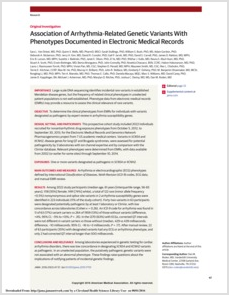Van Driest SL, Wells QS, Stallings S, Bush WS, Gordon A, Nickerson DA, Kim JH, Crosslin DR, Jarvik GP, Carrell DS, Ralston JD, Larson EB, Bielinski SJ, Olson JE, Ye Z, Kullo IJ, Abul-Husn NS, Scott SA, Bottinger E, Almoguera B, Connolly J, Chiavacci R, Hakonarson H, Rasmussen-Torvik LJ, Pan V, Persell SD, Smith M, Chisholm RL, Kitchner TE, He MM, Brilliant MH, Wallace JR, Doheny KF, Shoemaker MB, Li R, Manolio TA, Callis TE, Macaya D, Williams MS, Carey D, Kapplinger JD, Ackerman MJ, Ritchie MD, Denny JC, Roden DM,.
Large-scale DNA sequencing identifies incidental rare variants in established Mendelian disease genes, but the frequency of related clinical phenotypes in unselected patient populations is not well established. Phenotype data from electronic medical records (EMRs) may provide a resource to assess the clinical relevance of rare variants.To determine the clinical phenotypes from EMRs for individuals with variants designated as pathogenic by expert review in arrhythmia susceptibility genes.This prospective cohort study included 2022 individuals recruited for nonantiarrhythmic drug exposure phenotypes from October 5, 2012, to September 30, 2013, for the Electronic Medical Records and Genomics Network Pharmacogenomics project from 7 US academic medical centers. Variants in SCN5A and KCNH2, disease genes for long QT and Brugada syndromes, were assessed for potential pathogenicity by 3 laboratories with ion channel expertise and by comparison with the ClinVar database. Relevant phenotypes were determined from EMRs, with data available from 2002 (or earlier for some sites) through September 10, 2014.One or more variants designated as pathogenic in SCN5A or KCNH2.Arrhythmia or electrocardiographic (ECG) phenotypes defined by International Classification of Diseases, Ninth Revision (ICD-9) codes, ECG data, and manual EMR review.Among 2022 study participants (median age, 61 years [interquartile range, 56-65 years]; 1118 [55%] female; 1491 [74%] white), a total of 122 rare (minor allele frequency 0.5%) nonsynonymous and splice-site variants in 2 arrhythmia susceptibility genes were identified in 223 individuals (11% of the study cohort). Forty-two variants in 63 participants were designated potentially pathogenic by at least 1 laboratory or ClinVar, with low concordance across laboratories (Cohen κ 0.26). An ICD-9 code for arrhythmia was found in 11 of 63 (17%) variant carriers vs 264 of 1959 (13%) of those without variants (difference, 4%; 95% CI, -5% to 13%; P .35). In the 1270 (63%) with ECGs, corrected QT intervals were not different in variant carriers vs those without (median, 429 vs 439 milliseconds; difference, -10 milliseconds; 95% CI, -16 to 3 milliseconds; P .17). After manual review, 22 of 63 participants (35%) with designated variants had any ECG or arrhythmia phenotype, and only 2 had corrected QT interval longer than 500 milliseconds.Among laboratories experienced in genetic testing for cardiac arrhythmia disorders, there was low concordance in designating SCN5A and KCNH2 variants as pathogenic. In an unselected population, the putatively pathogenic genetic variants were not associated with an abnormal phenotype. These findings raise questions about the implications of notifying patients of incidental genetic findings.

